Prediction Methods and Experimental Techniques for Chatter Avoidance in Turning Systems: A Review
Abstract
1. Introduction
2. Vibration Prediction in Turning Processes
3. Experimental Techniques
3.1. Experimental Techniques for Chatter Avoidance
3.2. On-Line Chatter Classification, Detection, and Monitoring
4. Passive and Active Suppression Techniques
4.1. Passive Chatter Suppression Techniques
4.2. Active Chatter Suppression Techniques
5. Practical Solutions for Industry
- -
- CutPro/MachPro/ChatterPro/SpindlePro/NPro© (developed in the Manufacturing Laboratory of the British Columbia University, Vancouver under the direction of Professor Y. Altintas [115]): probably represents the best package to solve problems in machining as these functionalities deal with different machining aspects/problems. Cut Pro was the original software resulting in a wide family of products. It allows determining the best cutting parameters. As usual, prior to the simulations, the customer needs to identify the dynamic parameters (modal mass, damping ratio, and stiffness) of the tool/piece system as well as cutting coefficients. If one of the following elements is changed: (1) machine-tool and/or fixtures; (2) workpiece material (maybe the same material but from another batch); (3) cutting tool (overhang, toolholder, wear), the system needs to be characterized again because, in general, the cutting coefficients and the modal parameters will be different. To obtain the modal parameters, the software is capable of performing 3D modal analysis to filter and process the transfer functions and to obtain the fundamental modes. These are then used to simulate the stability lobes. SpindlePro is focused on the design and analysis of spindle systems; NPro is the implementation of CAM (Computer-Aided Manufacturing) and its combination with chatter requisites. The software is capable of simulating and optimizing tool paths.
- -
- Harmonizer© (developed in the MLI (Manufacturing Laboratories Inc.) of Las Vegas [116]): this software has been developed by years of experience for the control and reduction of vibrations in machining and leading to different packages: MilSim, CRAC (Chatter Avoidance and Recognition), MTDA (Machine Tool Dynamic Analyzer) and finally, Harmonizer©. Given a certain depth of cut and spindle speed, the analysis of the acoustic signal during machining allows to determine chatter frequency if the cut is unstable. In two or three iterations, the program is able to find a suitable spindle speed where the cut is free of chatter. If the initial depth of cut is too far from the final one or the modes are highly variable (magnitude and direction) over time such as in finishing operations, the system may have converging difficulties. Therefore, the system is more useful for 1-DOF systems and roughing operations. Recently, researchers presented BlueSwarf (MetalMAX©) which is an evolution for the rapid characterization of cutting process dynamics.
- -
- EMMATools from SMARTIbox© (Spindle Measuring and Analyzing Relevant Tool for Industry Box): this software emerged from the collaboration between the University of Nantes [117] and the Airbus company for the monitoring and preventive maintenance of high-speed spindles. Rotor displacements are measured, cutting frequency harmonics are analyzed through embedded sensors. By means of spindle monitoring, the stress levels and associated frequencies are controlled for the best benefit of spindle life, thus protecting the bearings.
- -
- Machining Navi© [118]: machine builders are also interested in selling machines with superior capacities. Machining Navi is one of the latest developments from Okuma for solving online chatter problems, it integrates a detection software within the numerical control of the machine itself. In this case, the chatter avoidance system uses the value of vibration captured by a sensor (amplitude and frequency) and other parameters (number of cutting edges, range of allowed speeds, threshold values for detection) to modify the spindle speed and the feed-axis for a more stable cut. The program can work on its own or be activated/deactivated by the operator and allows them to apply the speed before detecting chatter onset.
- -
- Makino: Makino Milling Machine (Tokyo, JP) patented a method [119] for chatter avoidance in machining systems (US 9.285,797 B2). This method was based on acquiring vibration data of the tool at a predetermined sampling period, then deciding as fast as possible whether the vibration data being processed matches an integral multiple of the calculated period or not.
- -
- Blue Swarf© [120,121] is a company that emerged from the expertise of Dr. Smith (University of North Carolina at Charlotte), Dr. Delio (President of Manufacturing Laboratories Inc. MLI), Mr. Barton (Founder and President of American Machinist), and Dr. Schmitz (University of North Carolina at Charlotte.). This software offers patches to solve vibrations problems in machining. Customers make use of individual dashboards for the identification of a particular machine tool-spindle-tool + material assembly. As a result, Blue Swarf makes a recommendation on the best cutting parameters. However, the software is more oriented to solve problems for milling rather than turning.
- -
- ChatterMaster [122,123]: from the University of Tarbes (ENIT), it follows the same approach by Pr. Altintas or MLI with Harmonizer. After extracting data of the machining system (spindle-tool material and cutting conditions) the software gives a recommendation for the best spindle speed to avoid chatter. Recently, ChatterMaster has developed a new module for chatter avoidance in turning operations.
6. Conclusions
Author Contributions
Funding
Acknowledgments
Conflicts of Interest
Appendix A. Publications Related to Chatter Stability Prediction
| Category | Publications | Number of Publications |
|---|---|---|
| Frequency-domain methods | [22,23,24,25,26,27,29,30,31,35,36,37,41,42,44,46,47,48,49,50,58,63,64,65,66] | 25 |
| Numerical methods giving time-domain solution | [28,32,34,43,45,51,52,54,67,68] | 10 |
| Numerical methods for stability prediction | [33,52,54,55,56,57,59,60,81,85,86] | 11 |
Appendix B. Publications Related to Experimental Techniques
References
- Taylor, F. On the Art of Cutting Metals; The American Society of Mechanical Engineers: New York, NY, USA, 1907. [Google Scholar]
- Yamane, Y.; Ryutaro, T.; Tadanori, S.; Martinez-Ramirez, I.; Keiji, Y. A new quantitative evaluation for characteristic of surface roughness in turning. Precis. Eng. 2017, 50, 20–26. [Google Scholar] [CrossRef]
- Nieslony, P.; Krolczyk, G.; Wojciechowski, S.; Chudy, R.; Zak, K.; Maruda, R. Surface quality and topographic inspection of variable compliance part after precise turning. Appl. Surf. Sci. 2018, 434, 91–101. [Google Scholar] [CrossRef]
- Asthakov, V.P.; Davim, J.P. Tools (Geometry and Material) and Tool Wear. In Machining; Springer: Berlin/Heidelberg, Germany, 2008; pp. 29–57. [Google Scholar]
- Asthakov, V.P.; Outeiro, J.C. Metal Cutting Mechanics, Finite Element Modelling. In Machining; Springer: Berlin/Heidelberg, Germany, 2008; pp. 1–27. [Google Scholar]
- Rech, J.; Hamdi, H.; Valette, S. Workpiece surface integrity. In Machining; Springer: Berlin/Heidelberg, Germany, 2008; pp. 59–96. [Google Scholar]
- Asthakov, V.P.; Davim, J.P. Machining of Hard Materials. In Machining; Springer: Berlin/Heidelberg, Germany, 2008; pp. 97–126. [Google Scholar]
- Lopez de Lacalle, L.N.; Lamikiz, A. Machine Tools for High Performance Machining; Springer: Berlin/Heidelberg, Germany, 2009. [Google Scholar]
- Arnold, R.N. The mechanism of tool vibration in the cutting of steel. Proc. Inst. Mech. Eng. 1946, 154, 261–284. [Google Scholar] [CrossRef]
- Tobias, S.A.; Fishwick, W. The chatter of lathe tools under orthogonal cutting conditions. Trans. ASME 1958, 80, 1079–1088. [Google Scholar]
- Tlusty, J.; Polacek, M. The stability of machine tools against self excited vibrations in machining. In Proceedings of the International Research in Production Engineering Conference, Pittsburgh, PA, USA, 9–12 September 1963; ASME: New York, NY, USA, 1963; pp. 465–474. [Google Scholar]
- Tobias, S.A. Machine Tool Vibration; Blackie and Sons Ltd.: Glasglow, UK, 1965. [Google Scholar]
- Meritt, H.E. Theory of self-excited machine–tool chatter. Trans. ASME 1965, 87, 447–454. [Google Scholar]
- Siddhpura, M.; Paurobally, R. A review of chatter vibration research in turning. Int. J. Mach. Tools Manuf. 2012, 61, 27–47. [Google Scholar] [CrossRef]
- Kashyzadeh, K.R.; Ostad-Ahmad-Ghorabi, M.J. Study of chatter analysis in turning tool and control methods—A Review. Int. J. Emerg. Technol. Adv. Eng. 2012, 2, 1–5. [Google Scholar]
- Tlusty, J. Dynamics of high-speed milling. J. Eng. Ind. 1986, 108, 59–67. [Google Scholar] [CrossRef]
- Marui, E.; Ema, S.; Kato, S. Chatter Vibration of Lathe Tools. Part 1: General Characteristics of Chatter Vibration. J. Eng. Ind. 1983, 105, 100–106. [Google Scholar] [CrossRef]
- Marui, E.; Ema, S.; Kato, S. Chatter vibration of lathe tools. Part 2: On the mechanism of exciting energy supply. Trans. ASME 1983, 105, 107–113. [Google Scholar] [CrossRef]
- Kaneko, T.; Sato, H.; Tani, Y.; O-Hori, M. Self-Excited Chatter and its Marks in Turning. J. Eng. Ind. 1984, 106, 222–228. [Google Scholar] [CrossRef]
- Minis, I.E.; Magrab, E.B.; Pandelidis, I.O. Improved Methods for the Prediction of Chatter in Turning, Part 3: A Generalized Linear Theory. J. Eng. Ind. 1990, 112, 28–35. [Google Scholar] [CrossRef]
- Yanushevsky, R.; Minis, I. A New Theoretical Approach for the Prediction of Machine Tool Chatter in Milling. J. Eng. Ind. 1993, 115, 1–8. [Google Scholar]
- Rao, B.C.; Shin, Y.C. A comprehensive dynamic cutting force model for chatter prediction in turning. Int. J. Mach. Tools Manuf. 1999, 39, 1631–1654. [Google Scholar] [CrossRef]
- Budak, E.; Altintas, Y. Analytical prediction of the chatter stability in milling Part I: General formulation. J. Dyn. Syst. Meas. Control 1998, 120, 22–30. [Google Scholar] [CrossRef]
- Clancy, B.E.; Shin, Y.C. A comprehensive chatter prediction model for face turning operation including tool wear effect. Int. J. Mach. Tools Manuf. 2002, 42, 1035–1044. [Google Scholar] [CrossRef]
- Ozdoganlar, O.B.; Endres, W.J. An analytical stability solution for the turning process with depth-direction dynamics and corner-radiused tooling. Trans. ASME 1998, 511–518. [Google Scholar]
- Ozdoganlar, O.B.; Endres, W.J. An analytical representation of chip Area for corner-radiused tools under depth-of-cut and feed variations. Trans. ASME 2000, 122, 660–665. [Google Scholar] [CrossRef]
- Reddy, R.G.; Ozdoganlar, O.B.; Kapoor, S.G.; Devor, R.E.; Liu, X. A Stability Solution for the Axial Contour-Turning Process. J. Manuf. Sci. Eng. 2002, 124, 581–587. [Google Scholar] [CrossRef]
- Lazoglu, I.; Atabey, F.; Altintas, Y. Dynamic of boring processes—Part III: Time domain. Int. J. Mach. Tools Manuf. 2002, 42, 1567–1576. [Google Scholar] [CrossRef]
- Ozlu, E.; Budak, E. Analytical Modeling of Chatter Stability in turning and boring operations—Part I: Model Development. J. Manuf. Sci. Eng. 2007, 129, 726–732. [Google Scholar] [CrossRef]
- Ozlu, E.; Budak, E. Analytical modeling of chatter stability in turning and boring operations, Part II: Experimental verification. J. Manuf. Sci. Eng. 2007, 129, 733–739. [Google Scholar] [CrossRef]
- Ozlu, E.; Budak, E. Comparison of one-dimensional oriented transfer function stability model vs. multi- dimensional stability model in turning operations. Int. J. Mach. Tools Manuf. 2007, 129, 726–732. [Google Scholar]
- Chandiramani, N.K.; Pothala, T. Dynamics of 2-DOF regenerative chatter during turning. J. Sound Vib. 2006, 290, 448–464. [Google Scholar] [CrossRef][Green Version]
- Urbikain, G.; Fernández, A.; De Lacalle, L.L.; Gutiérrez, M.; Pelayo, G.U.; De Lacalle, L.N.L. Stability lobes for general turning operations with slender tools in the tangential direction. Int. J. Mach. Tools Manuf. 2013, 67, 35–44. [Google Scholar] [CrossRef]
- Dassanayake, A.V.; Suh, C.S. On nonlinear cutting response and tool chatter in turning operation. Commun. Nonlinear Sci. Numer. Simul. 2008, 13, 979–1001. [Google Scholar] [CrossRef]
- Otto, A.; Rauh, S.; Kolouch, M.; Radons, G. Extension of Tlusty’s law for the identification of chatter stability lobes in multi-dimensional cutting processes. Int. J. Mach. Tools Manuf. 2014, 82, 50–58. [Google Scholar] [CrossRef]
- Tlusty, J. High-speed machining. CIRP Ann. 1993, 42, 733–738. [Google Scholar] [CrossRef]
- Eynian, M. Chatter Stability of Turning and Milling with Process Damping. Ph.D. Thesis, University of British Columbia, Vancouver, BC, Canada, 2010. [Google Scholar]
- Colwell, L.V. Predicting the Angle of Chip Flow for Single Point Cutting Tools. Trans. ASME 1954, 76, 199–204. [Google Scholar]
- Sisson, T.R.; Kegg, R.L. An explanation of low-speed chatter effects. J. Eng. Ind. 1969, 91, 951–958. [Google Scholar] [CrossRef]
- Tlusty, J. Analysis of state of research in cutting dynamic. CIRP Ann. 1978, 27, 583–589. [Google Scholar]
- Altintas, Y.; Eynian, M.; Onozuka, H. Identification of dynamic cutting force coefficients and chatter stability with process damping. CIRP Ann. 2008, 57, 371–374. [Google Scholar] [CrossRef]
- Budak, E.; Tunc, L.T. A New Method for Identification and Modeling of Process Damping in Machining. J. Manuf. Sci. Eng. 2009, 131, 051019. [Google Scholar] [CrossRef]
- Ahmadi, K.; Ismail, F. Experimental investigation of process damping non linearity in machining chatter. Int. J. Mach. Tools Manuf. 2010, 50, 1006–1014. [Google Scholar] [CrossRef]
- Tyler, C.T.; Troutman, J.R.; Schmitz, T.L. A coupled dynamics, multiple degree of freedom process damping model, Part 1: Turning. Precis. Eng. 2016, 46, 65–72. [Google Scholar] [CrossRef]
- Wang, Z.; Cleghorn, W. Stability analysis of spinning stepped-shaft workpieces in a turning process. J. Sound Vib. 2002, 250, 356–367. [Google Scholar] [CrossRef]
- Sekar, M.; Srinivas, J.; Kotaiah, K.; Yang, S. Stability analysis of turning process with tailstock-supported workpiece. Int. J. Adv. Manuf. Technol. 2009, 43, 862–871. [Google Scholar] [CrossRef]
- Vela-Martínez, L.; Jáuregui-Correa, J.C.; Rubio-Cerda, E.; Herrera-Ruiz, G.; Lozano-Guzmán, A. Analysis of compliance between the cutting tool and the workpiece on the stability of a turning process. Int. J. Mach. Tools Manuf. 2008, 48, 1054–1062. [Google Scholar] [CrossRef]
- Chen, C.; Tsao, Y. A stability analysis of turning a tailstock supported flexible work-piece. Int. J. Mach. Tools Manuf. 2006, 46, 18–25. [Google Scholar] [CrossRef]
- Chen, C.-K.; Tsao, Y.-M. A stability analysis of regenerative chatter in turning process without using tailstock. Int. J. Adv. Manuf. Technol. 2006, 29, 648–654. [Google Scholar] [CrossRef]
- Yu, S.D.; Shah, V. Theoretical and Experimental Studies of Chatter in Turning for Uniform and Stepped Workpieces. J. Vib. Acoust. 2008, 130, 061005. [Google Scholar] [CrossRef]
- Chanda, A.; Dwivedy, S.K. Nonlinear dynamic analysis of flexible workpiece and tool in turning operation with delay and internal resonance. J. Sound Vib. 2018, 434, 358–378. [Google Scholar] [CrossRef]
- Gyebrószki, G.; Bachrathy, D.; Csernák, G.; Stepan, G. Stability of turning processes for periodic chip formation. Adv. Manuf. 2018, 6, 345–353. [Google Scholar] [CrossRef]
- Copenhaver, R.; Schmitz, T.; Smith, S. Stability analysis of modulated tool path turning. CIRP Ann. 2018, 67, 49–52. [Google Scholar] [CrossRef]
- Urbikain, G.; Campa, F.J.; Zulaika, J.-J.; De Lacalle, L.-N.L.; Alonso, M.-A.; Collado, V. Preventing chatter vibrations in heavy-duty turning operations in large horizontal lathes. J. Sound Vib. 2015, 340, 317–330. [Google Scholar] [CrossRef]
- Urbikain, G.; Olvera, D.; De Lacalle, L.N.L.; Elías-Zúñiga, A.; Pelayo, G.U. Stability and vibrational behaviour in turning processes with low rotational speeds. Int. J. Adv. Manuf. Technol. 2015, 80, 871–885. [Google Scholar] [CrossRef]
- Otto, A.; Khasawneh, F.A.; Radons, G. Position-dependent stability analysis of turning with tool and workpiece compliance. Int. J. Adv. Manuf. Technol. 2015, 79, 1453–1463. [Google Scholar] [CrossRef]
- Urbikain, G.; De Lacalle, L.L.; Campa, F.J.; Fernández, A.; Elias, A.; De Lacalle, L.N.L. Stability prediction in straight turning of a flexible workpiece by collocation method. Int. J. Mach. Tools Manuf. 2012, 54, 73–81. [Google Scholar] [CrossRef]
- Lu, K.; Lian, Z.; Gu, F.; Liu, H. Model-based chatter stability prediction and detection for the turning of a flexible workpiece. Mech. Syst. Signal Process. 2018, 100, 814–826. [Google Scholar] [CrossRef]
- Urbikain, G.; De Lacalle, L.L.; Fernández, A.; De Lacalle, L.N.L. Regenerative vibration avoidance due to tool tangential dynamics in interrupted turning operations. J. Sound Vib. 2014, 333, 3996–4006. [Google Scholar] [CrossRef]
- Palacios, J.; Olvera, D.; Urbikain, G.; Elías-Zúñiga, A.; Martínez-Romero, O.; De Lacalle, L.L.; Rodríguez, C.; Martínez-Alfaro, H. Combination of simulated annealing and pseudo spectral methods for the optimum removal rate in turning operations of nickel-based alloys. Adv. Eng. Softw. 2018, 115, 391–397. [Google Scholar] [CrossRef]
- Qiu, J.; Ge, R. An improved stability lobe and turning chatter characteristic investigation. Int. J. Mech. Sci. 2018, 149, 338–348. [Google Scholar] [CrossRef]
- Jasiewicz, M.; Miadlicki, K. Implementation of an algorithm to prevent chatter vibration in a CNC system. Materials 2019, 12, 3193. [Google Scholar] [CrossRef] [PubMed]
- Budak, E.; Ozturk, E. Dynamics and stability of parallel turning operations. CIRP Ann. 2011, 60, 383–386. [Google Scholar] [CrossRef]
- Ozturk, E.; Comak, A.; Budak, E. Tuning of tool dynamics for increased stability of parallel (simultaneous) turning processes. J. Sound Vib. 2016, 360, 17–30. [Google Scholar] [CrossRef]
- Reith, M.J.; Bachrathy, D.; Stepan, G. Optimal detuning of a parallel turning system—Theory and experiments. J. Dyn. Sys. Meas. Control 2017, 139, 014503. [Google Scholar] [CrossRef]
- Reith, M.J.; Stepan, G. Effect of non-proportional damping on the dynamics and stability of multi-cutter turning systems. Int. J. Mach. Tools Manuf. 2017, 117, 23–30. [Google Scholar] [CrossRef]
- Azvar, M.; Budak, E. Multi-dimensional chatter stability for enhanced productivity in different parallel turning strategies. Int. J. Mach. Tools Manuf. 2017, 123, 116–128. [Google Scholar] [CrossRef]
- Gouskov, A.M.; Guskov, M.A.; Tung, D.D.; Panovko, G.Y. Modeling and Investigation of the Stability of a Multicutter Turning Process by a Trace. J. Mach. Manuf. Reliab. 2018, 47, 317–323. [Google Scholar] [CrossRef]
- Inamura, T.; Sata, T. Stability analysis of cutting under varying spindle speed. CIRP Ann. 1974, 23, 119–120. [Google Scholar]
- Takemura, T.; Kitamura, T.; Hoshi, T.; Okushimo, K. Active suppression of chatter by programmed variation of spindle speed. CIRP Ann. 1974, 23, 121–122. [Google Scholar]
- Sexton, J.; Milne, R.; Stone, B. A stability analysis of single-point machining with varying spindle speed. Appl. Math. Model. 1977, 1, 310–318. [Google Scholar] [CrossRef]
- Hoshi, T.; Sakisaka, N.; Moriyama, I.; Sato, M. Study for practical application of fluctuating speed cutting for regenerative chatter control. CIRP Ann. 1977, 25, 175–179. [Google Scholar]
- Tsao, T.; McCarthy, M.; Kapoor, S.G. A New Approach to Stability Analysis of Variable Speed Machining Systems. Int. J. Mach. Tools Manuf. 1933, 33, 791–808. [Google Scholar] [CrossRef]
- Soliman, E.; Ismail, F. Chatter Suppression by Adaptive Speed Modulation. Int. J. Mach. Tools Manuf. 1977, 37, 355–369. [Google Scholar] [CrossRef]
- Jayaram, S.; Kapoor, S.G.; DeVor, R.E. Analytical stability analysis of variable spindle speed machining. J. Manuf. Sci. Eng. 2000, 122, 391–397. [Google Scholar] [CrossRef]
- Al-Regib, E.; Ni, J.; Lee, S.-H. Programming spindle speed variation for machine tool chatter suppression. Int. J. Mach. Tools Manuf. 2003, 43, 1229–1240. [Google Scholar] [CrossRef]
- Zhang, H.H.; Jackson, M.J.; Ni, J. Spindle speed variation method for regenerative machining chatter control. Int. J. Nanomanuf. 2009, 3, 73–99. [Google Scholar] [CrossRef]
- Zatarain, M.; Bediaga, I.; Muñoa, J.; Lizarralde, R. Stability of milling processes with continuous spindle speed variation: Analysis in the frequency and time domains, and experimental correlation. CIRP Ann. 2008, 57, 379–384. [Google Scholar] [CrossRef]
- Bediaga, I. Regenerative Chatter Suppression by Means of Variable Spindle Speed. Ph.D. Thesis, Dpt. of Mechanical Engineering, UPV/EHU, Bilbao, Spain, 2009. [Google Scholar]
- Barrenetxea, D.; Marquinez, J.; Bediaga, I.; Uriarte, L. Continuous workpiece speed variation (CWSV): Model based practical application to avoid chatter in grinding. CIRP Ann. 2009, 58, 319–322. [Google Scholar] [CrossRef]
- Insperger, T.; Stepan, G. Semi-Discretization for Time-Delay Systems: Stability and Engineering Applications; Springer: London, UK, 2010. [Google Scholar]
- Wu, D.; Chen, K.; Wang, X. An investigation of practical application of variable spindle speed machining to noncircular turning process. Int. J. Adv. Manuf. Technol. 2009, 44, 1094–1105. [Google Scholar] [CrossRef]
- Wu, D.; Chen, K. Chatter suppression in fast tool servo-assisted turning by spindle speed variation. Int. J. Mach. Tools Manuf. 2010, 50, 1038–1047. [Google Scholar] [CrossRef]
- Yilmaz, A.; Al Regib, E.; Ni, J. Machine Tool Chatter Suppression by Multi Level Random Spindle Speed Variation. J. Manuf. Sci. Eng. 2002, 124, 208–216. [Google Scholar] [CrossRef]
- Otto, A.; Radons, G. Application of spindle speed variation for chatter suppression in turning. CIRP J. Manuf. Sci. Technol. 2013, 6, 102–109. [Google Scholar] [CrossRef]
- Urbikain, G.; Olvera, D.; De Lacalle, L.L.; Elías-Zúñiga, A. Spindle speed variation technique in turning operations: Modeling and real implementation. J. Sound Vib. 2016, 383, 384–396. [Google Scholar] [CrossRef]
- Yang, F.; Zhang, B.; Yu, J. Chatter suppression with multiple time-varying parameters in turning. J. Mater. Process. Technol. 2003, 141, 431–438. [Google Scholar] [CrossRef]
- Yao, Z.; Mei, D.; Chen, Z. On-line chatter detection and identification based on wavelet and support vector machine. J. Mater. Process. Technol. 2010, 210, 713–719. [Google Scholar] [CrossRef]
- Yamato, S.; Hirano, T.; Yamada, Y.; Koike, R.; Kakinuma, Y. Sensor-less on-line chatter detection in turning process based on phase monitoring using power factor theory. Precis. Eng. 2018, 51, 103–116. [Google Scholar] [CrossRef]
- Khasawneh, F.A.; Munch, E. Chatter detection in turning using persistent homology. Mech. Syst. Signal Process. 2016, 70, 527–541. [Google Scholar] [CrossRef]
- Khasawneh, F.A.; Munch, E.; Perea, J.A. Chatter Classification in Turning using Machine Learning and Topological Data Analysis. IFAC-PapersOnLine 2018, 51, 195–200. [Google Scholar] [CrossRef]
- Tansel, I.N. Modelling 3-D cutting dynamics with neural networks. Int. J. Mach. Tools Manuf. 1992, 32, 829–853. [Google Scholar] [CrossRef]
- Cherukuri, H.; Perez-Bernabeu, E.; Selles, M.; Schmitz, T.L. A neural network approach for chatter prediction in turning. Procedia Manuf. 2019, 34, 885–892. [Google Scholar] [CrossRef]
- Kumar, S.; Singh, B. Prediction of tool chatter in turning using RSM and ANN. Mater. Today Proc. 2018, 5, 23806–23815. [Google Scholar] [CrossRef]
- Shrivastava, Y.; Singh, B.; Sharma, A. Identification of Chatter in Turning Operation using WD and EMD. Mater. Today Proc. 2018, 5, 23917–23926. [Google Scholar] [CrossRef]
- Kim, S.; Ahmadi, K. Estimation of vibration stability in turning using operational modal analysis. Mech. Syst. Signal Process. 2019, 130, 315–332. [Google Scholar] [CrossRef]
- Liu, Y.; Li, T.-X.; Liu, K.; Zhang, Y.-M. Chatter reliability prediction of turning process system with uncertainties. Mech. Syst. Signal Process. 2016, 66, 232–247. [Google Scholar] [CrossRef]
- Huang, X.; Hu, M.; Zhang, Y.; Lv, C. Probabilistic analysis of chatter stability in turning. Int. J. Adv. Manuf. Technol. 2016, 87, 3225–3232. [Google Scholar] [CrossRef]
- Cortadi, A.J.; Irigoien, I.; Boto, F.; Sierra, B.; Suarez, A.; Galar, D. A statistical data-based approach to instability detection and wear prediction in radial turning processes. Ekspolatacja Niezawodn. Maint. Reliab. 2018, 20, 405–412. [Google Scholar] [CrossRef]
- Tian, A.-H.; Fu, C.-B.; Su, X.-Y.; Yau, H.-T. Lathe tool chatter vibration diagnostic using general regression neural network based on Chua’s circuit and fractional-order Lorenz master/slave chaotic system. J. Low Freq. Noise Vib. Act. Control 2018, 38, 953–966. [Google Scholar] [CrossRef]
- Houck, L.; Schmitz, T.L.; Smith, K.S. A tuned holder for increased boring bar dynamic stiffness. J. Manuf. Process. 2011, 13, 24–29. [Google Scholar] [CrossRef]
- Moradi, H.; Bakhtiari-Nejad, F.; Movahhedy, M. Tuneable vibration absorber design to suppress vibrations: An application in boring manufacturing process. J. Sound Vib. 2008, 318, 93–108. [Google Scholar] [CrossRef]
- Miguélez, M.H.; Rubio, L.; Loya, J.A.; Fernández-Sáez, J. Improvement of chatter stability in boring operations with assive vibration absorbers. Int. J. Mech. Sci. 2010, 52, 1376–1384. [Google Scholar] [CrossRef]
- Saffury, J.; Altus, E. Chatter resistance of non-uniform turning bars with attached dynamic absorbers—Analytical approach. J. Sound Vib. 2010, 329, 2029–2043. [Google Scholar] [CrossRef]
- Mohammadi, Y.; Azvar, M.; Budak, E. Suppressing vibration modes of spindle-holder-tool assembly through FRF modification for enhanced chatter stability. CIRP Ann. 2018, 67, 397–400. [Google Scholar] [CrossRef]
- Tewani, S.G.; Rouch, K.E.; Walcott, B.L. A study of cutting process stability of a boring bar with active dynamic absorber. Int. J. Mach. Tools Manuf. 1995, 35, 91–108. [Google Scholar] [CrossRef]
- Yigit, U.; Cigeroglu, E.; Budak, E. Chatter reduction in boring process by using piezoelectric shunt damping with experimental verification. Mech. Syst. Signal Process. 2017, 97, 312–321. [Google Scholar] [CrossRef]
- Martins da Silva, M.; Sardi, V.G.; Sérgio, V.P.; Teixeria, C.R. Experimental results on chatter reduction in turning through embedded piezoelectric material and passive shunt circuits. Mechatronics 2015, 29, 78–85. [Google Scholar] [CrossRef]
- Ma, H.; Wu, J.; Yang, L.; Xiong, Z. Active chatter suppression with displacement-only measurement in turning process. J. Sound Vib. 2017, 401, 255–267. [Google Scholar] [CrossRef]
- Liu, Y.; Liu, Z.; Song, Q.; Wang, B. Analysis and implementation of chatter frequency dependent constrained layer damping tool holder for stability improvement in turning process. J. Mater. Process. Technol. 2019, 266, 687–695. [Google Scholar] [CrossRef]
- Mei, D.; Yao, Z.; Kong, T.; Chen, Z. Parameter optimization of time-varying stiffness method for chatter suppression based on magnetorheological fluid-controlled boring bar. Int. J. Adv. Manuf. Technol. 2010, 46, 1071–1083. [Google Scholar] [CrossRef]
- Som, A.; Kim, D.-H.; Son, H. Semiactive Magnetorheological Damper for High Aspect Ratio Boring Process. IEEE/ASME Trans. Mechatron. 2015, 20, 5. [Google Scholar] [CrossRef]
- Mei, D.; Kong, T.; Shih, A.J.; Chen, Z. Magnetorheological fluid-controlled boring bar for chatter suppression. J. Mater. Process. Technol. 2009, 209, 1861–1870. [Google Scholar] [CrossRef]
- Lu, X.; Chen, F.; Altintas, Y. Magnetic actuator for active damping of boring bars. CIRP Ann. 2014, 63, 369–372. [Google Scholar] [CrossRef]
- Manufacturing Automation Laboratories. Available online: https://www.malinc.com/ (accessed on 22 July 2019).
- MetalMax, Manufacturing Laboratories Inc. Available online: https://www.mfg-labs.com/ (accessed on 22 July 2019).
- Analyse Vibratoire en Usinage. Available online: http://www.aic-et.fr/page-182-analyse-vibratoire-en-usinage-emmatools.html (accessed on 22 October 2019).
- Machining Navi, Okuma. Available online: https://www.okuma.com/machining-navi (accessed on 22 October 2019).
- Kondo, E. Chatter Vibration Detection Method, Chatter Vibration Avoidance Method, and Machine Tool. Patent No. US 9.285,797 B2, 15 March 2011. [Google Scholar]
- Available online: http://www.blueswarf.com/ (accessed on 17 October 2019).
- Available online: http://www.badaxetool.com/demos.html (accessed on 17 October 2019).
- Available online: http://www.vibraction.fr/index.php/fr/ (accessed on 17 October 2019).
- Available online: https://www.chattermaster.com (accessed on 17 October 2019).
- Urbikain, G.; Alvarez, A.; López de Lacalle, L.N.; Arsuaga, M.; Alonso, M.A.; Veiga, F. A Reliable Turning Process by the Early Use of a Deep Simulation Model at Several Manufacturing Stages. Machines 2017, 52, 15. [Google Scholar] [CrossRef]
- Polvorosa, R.; Suárez, A.; López de Lacalle, L.N.; Cerrillo, I.; Wretland, A.; Veiga, F. Tool wear on nickel alloys with different coolant pressures: Comparison of Alloy 718 and Waspaloy. J. Manuf. Process. 2017, 26, 44–56. [Google Scholar] [CrossRef]
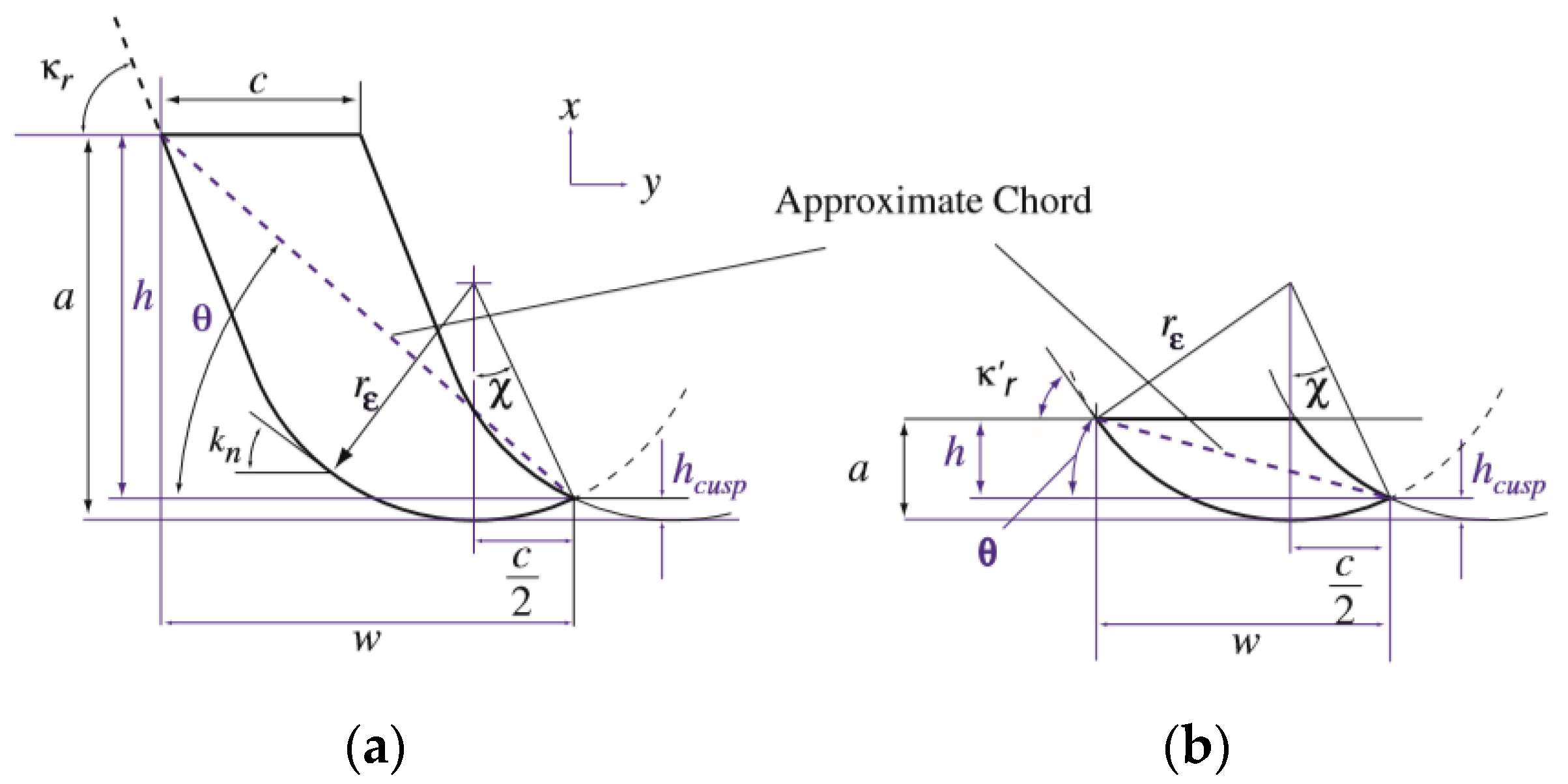
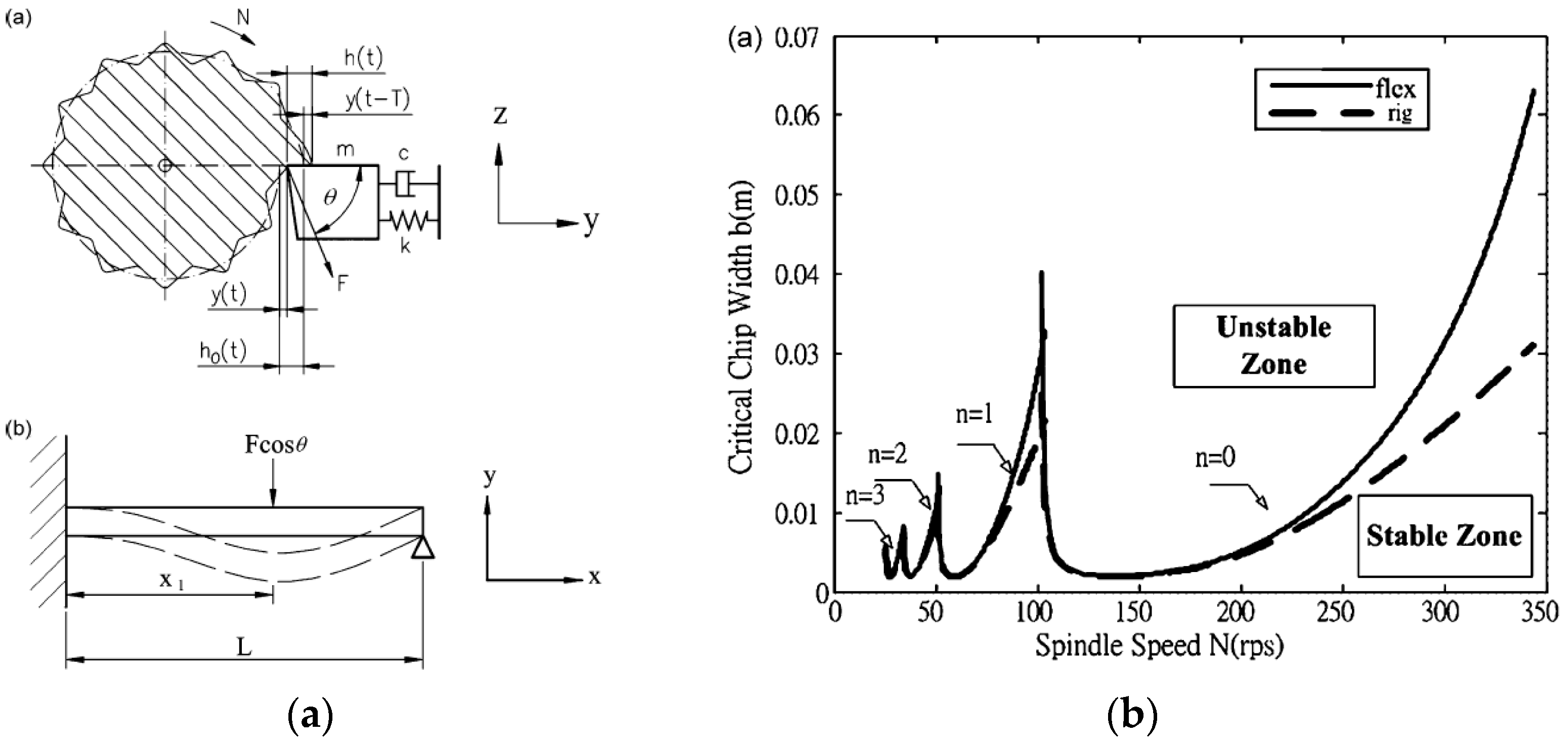
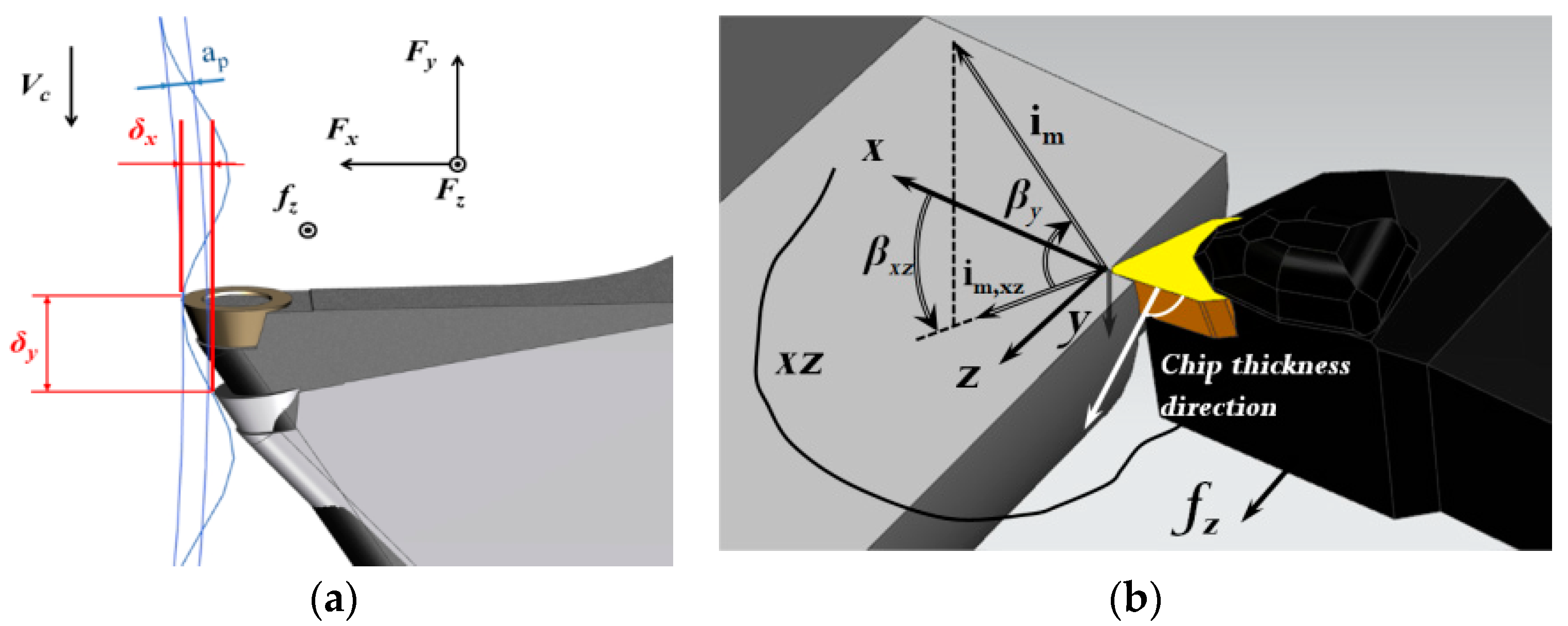
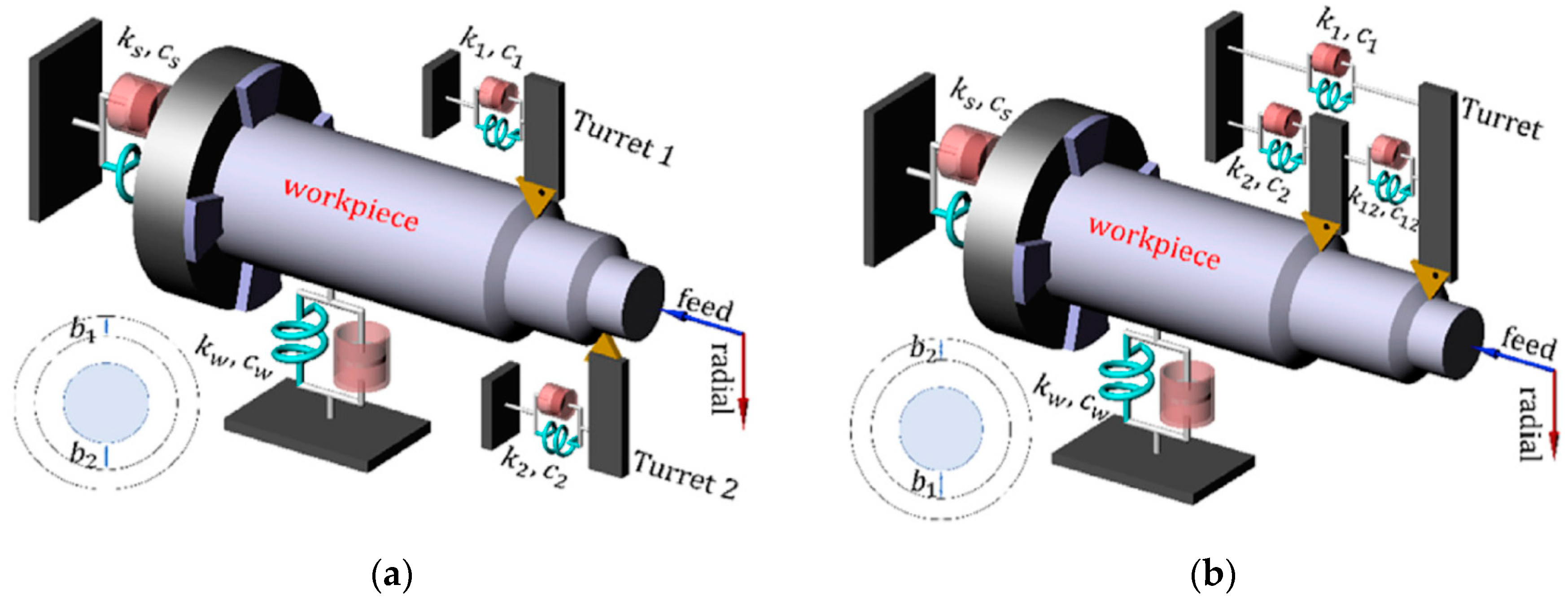

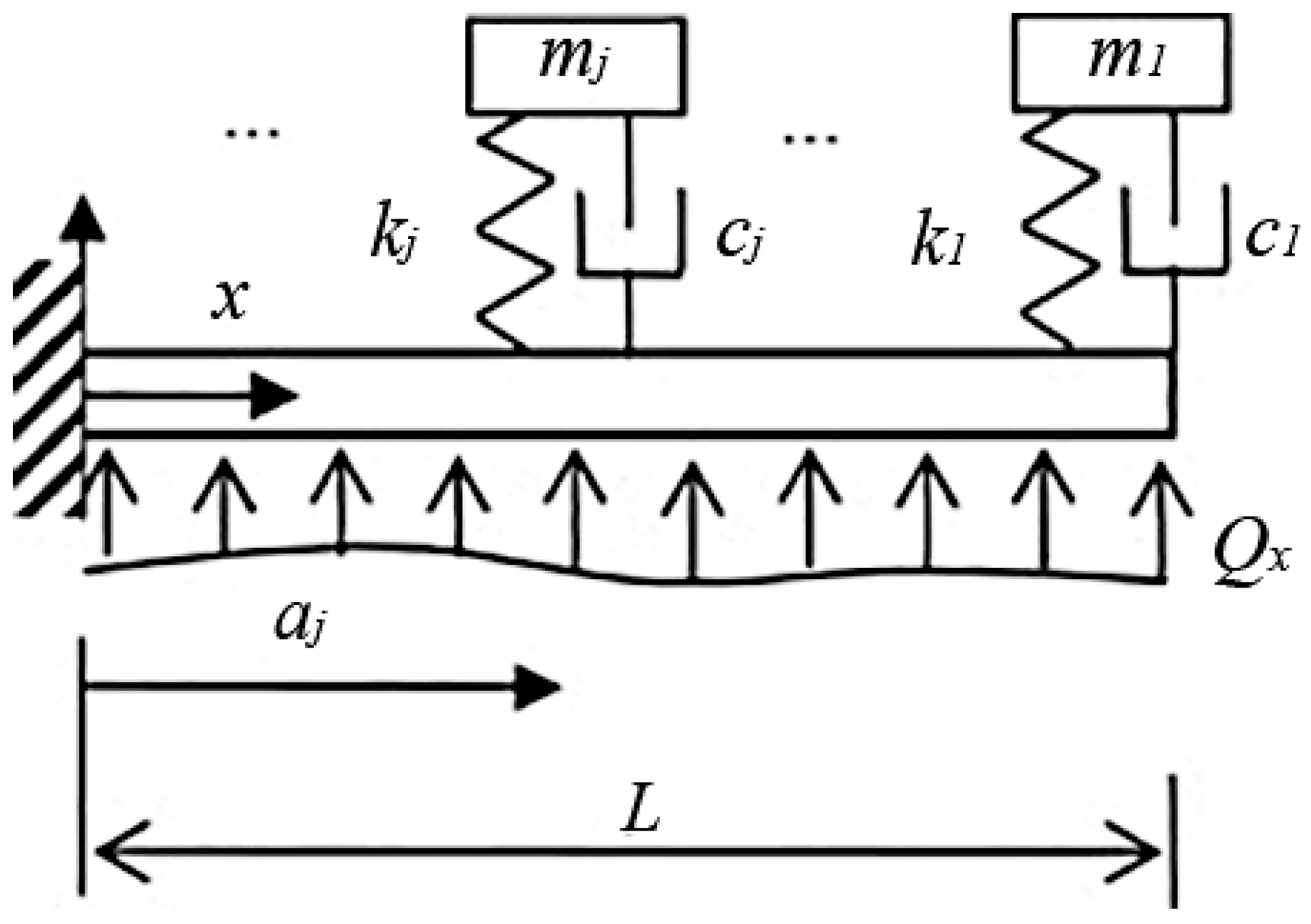

© 2019 by the authors. Licensee MDPI, Basel, Switzerland. This article is an open access article distributed under the terms and conditions of the Creative Commons Attribution (CC BY) license (http://creativecommons.org/licenses/by/4.0/).
Share and Cite
Urbikain, G.; Olvera, D.; López de Lacalle, L.N.; Beranoagirre, A.; Elías-Zuñiga, A. Prediction Methods and Experimental Techniques for Chatter Avoidance in Turning Systems: A Review. Appl. Sci. 2019, 9, 4718. https://doi.org/10.3390/app9214718
Urbikain G, Olvera D, López de Lacalle LN, Beranoagirre A, Elías-Zuñiga A. Prediction Methods and Experimental Techniques for Chatter Avoidance in Turning Systems: A Review. Applied Sciences. 2019; 9(21):4718. https://doi.org/10.3390/app9214718
Chicago/Turabian StyleUrbikain, Gorka, Daniel Olvera, Luis Norberto López de Lacalle, Aitor Beranoagirre, and Alex Elías-Zuñiga. 2019. "Prediction Methods and Experimental Techniques for Chatter Avoidance in Turning Systems: A Review" Applied Sciences 9, no. 21: 4718. https://doi.org/10.3390/app9214718
APA StyleUrbikain, G., Olvera, D., López de Lacalle, L. N., Beranoagirre, A., & Elías-Zuñiga, A. (2019). Prediction Methods and Experimental Techniques for Chatter Avoidance in Turning Systems: A Review. Applied Sciences, 9(21), 4718. https://doi.org/10.3390/app9214718









